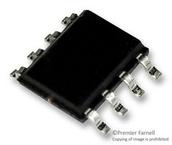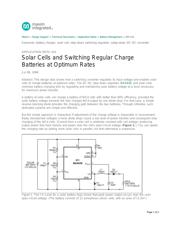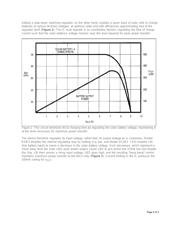下载

Maxim > Design Support > Technical Documents > Application Notes > Battery Management > APP 414
Keywords: battery charger, solar cell, step-down switching regulator, satep-down DC-DC converter
APPLICATION NOTE 414
Solar Cells and Switching Regular Charge
Batteries at Optimum Rates
Jul 09, 1998
Abstract: This design idea shows how a switching converter regulates its input voltage and enables solar
cells to charge batteries at optimum rates. The DC-DC step-down regulator, MAX639, and solar cells
minimize battery charging time by regulating and maintaining solar battery voltage at a level necessary
for maximum power transfer.
A battery of solar cells can charge a battery of NiCd cells with better than 80% efficiency, provided the
solar battery voltage exceeds the fully charged NiCd output by one diode drop. For that case, a simple
reverse-blocking diode provides the charging path between the two batteries. Through inflexible, such
dedicated systems are simple and effective.
But the simple approach is impractical if adjustment of the charge voltage is impossible or inconvenient.
Badly mismatched voltages (>>one diode drop) cause a low level of power transfer and consequent slow
charging of the NiCd cells. (Current from a solar cell is relatively constant with cell voltage, producing
output power that rises linearly and peaks near the cell's open-circuit voltage (Figure 1).) You can speed
the charging rate by adding more solar cells in parallel, but that alternative is expensive.
Figure 1. The I-V curve for a solar battery (top) shows that peak power output occurs near the cell's
open-circuit voltage. (The battery consists of 12 amorphous-silicon cells, with an area of 11.5in².)
Page 1 of 3





